Tag Archives: Data Science
RANSAC Regression Explained with Python Examples
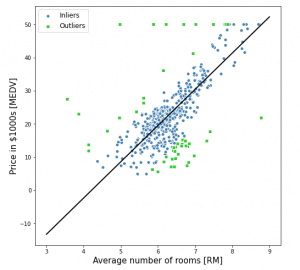
In this post, you will learn about the concepts of RANSAC regression algorithm along with Python Sklearn example for RANSAC regression implementation using RANSACRegressor. RANSAC regression algorithm is useful for handling the outliers dataset. Instead of taking care of outliers using statistical and other techniques, one can use RANSAC regression algorithm which takes care of the outlier data. In this post, the following topics are covered: Introduction to RANSAC regression RANSAC Regression Python code example Introduction to RANSAC Regression RANSAC (RANdom SAmple Consensus) algorithm takes linear regression algorithm to the next level by excluding the outliers in the training dataset. The presence of outliers in the training dataset does impact …
Beta Distribution Explained with Python Examples
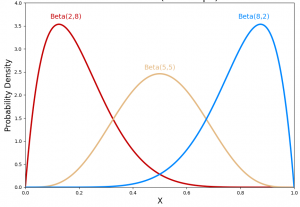
In this post, you will learn about Beta probability distribution with the help of Python examples. As a data scientist, it is very important to understand beta distribution as it is used very commonly as prior in Bayesian modeling. In this post, the following topics get covered: Beta distribution intuition and examples Introduction to beta distribution Beta distribution python examples Beta Distribution Intuition & Examples Beta distribution is widely used to model the prior beliefs or probability distribution in real world applications. Here is a great article on understanding beta distribution with an example of baseball game. You may want to pay attention to the fact that even if the baseball …
Bernoulli Distribution Explained with Python Examples
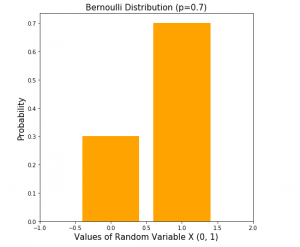
In this post, you will learn about the concepts of Bernoulli Distribution along with real-world examples and Python code samples. As a data scientist, it is very important to understand statistical concepts around various different probability distributions to understand the data distribution in a better manner. In this post, the following topics will get covered: Introduction to Bernoulli distribution Bernoulli distribution real-world examples Bernoulli distribution python code examples Introduction to Bernoulli Distribution Bernoulli distribution is a discrete probability distribution representing the discrete probabilities of a random variable which can take only one of the two possible values such as 1 or 0, yes or no, true or false etc. The probability of …
Deep Learning Explained Simply in Layman Terms
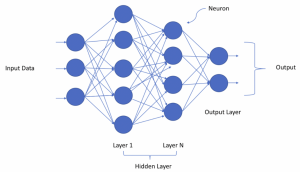
In this post, you will get to learn deep learning through simple explanation (layman terms) and examples. Deep learning is part or subset of machine learning and not something which is different than machine learning. Many of us when starting to learn machine learning try and look for the answers to the question “what is the difference between machine learning & deep learning?”. Well, both machine learning and deep learning is about learning from past experience (data) and make predictions on future data. Deep learning can be termed as an approach to machine learning where learning from past data happens based on artificial neural network (a mathematical model mimicking human brain). …
Bayes Theorem Explained with Examples
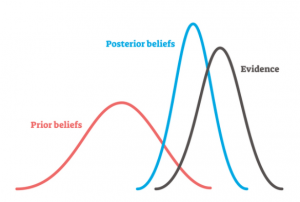
In this post, you will learn about Bayes’ Theorem with the help of examples. It is of utmost importance to get a good understanding of Bayes Theorem in order to create probabilistic models. Bayes’ theorem is alternatively called as Bayes’ rule or Bayes’ law. One of the many applications of Bayes’s theorem is Bayesian inference which is one of the approaches of statistical inference (other being Frequentist inference), and fundamental to Bayesian statistics. In this post, you will learn about the following: Introduction to Bayes’ Theorem Bayes’ theorem real-world examples Introduction to Bayes’ Theorem In simple words, Bayes Theorem is used to determine the probability of a hypothesis in the presence of more evidence or information. In other …
K-means Clustering Elbow Method & SSE Plot – Python
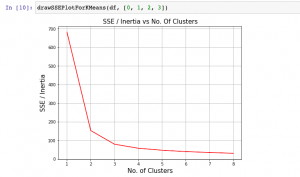
In this plot, you will quickly learn about how to find elbow point using SSE or Inertia plot with Python code and You may want to check out my blog on K-means clustering explained with Python example. The following topics get covered in this post: What is Elbow Method? How to create SSE / Inertia plot? How to find Elbow point using SSE Plot What is Elbow Method? Elbow method is one of the most popular method used to select the optimal number of clusters by fitting the model with a range of values for K in K-means algorithm. Elbow method requires drawing a line plot between SSE (Sum of Squared errors) …
Adaboost Algorithm Explained with Python Example
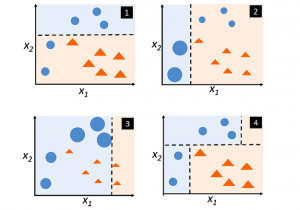
In this post, you will learn about boosting technique and adaboost algorithm with the help of Python example. You will also learn about the concept of boosting in general. Boosting classifiers are a class of ensemble-based machine learning algorithms which helps in variance reduction. It is very important for you as data scientist to learn both bagging and boosting techniques for solving classification problems. Check my post on bagging – Bagging Classifier explained with Python example for learning more about bagging technique. The following represents some of the topics covered in this post: What is Boosting and Adaboost Algorithm? Adaboost algorithm Python example What is Boosting and Adaboost Algorithm? As …
Hard vs Soft Voting Classifier Python Example
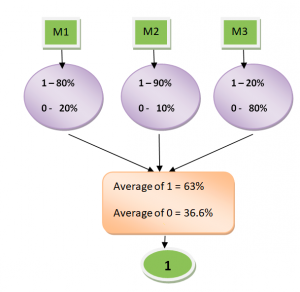
In this post, you will learn about one of the popular and powerful ensemble classifier called as Voting Classifier using Python Sklearn example. Voting classifier comes with multiple voting options such as hard and soft voting options. Hard vs Soft Voting classifier is illustrated with code examples. The following topic has been covered in this post: Voting classifier – Hard vs Soft voting options Voting classifier Python example Voting Classifier – Hard vs Soft Voting Options Voting Classifier is an estimator that combines models representing different classification algorithms associated with individual weights for confidence. The Voting classifier estimator built by combining different classification models turns out to be stronger meta-classifier that balances out the individual …
Keras Hello World Example
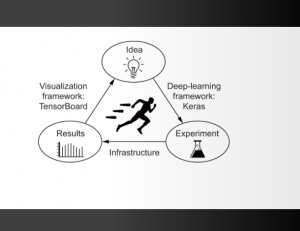
In this post, you will learn about how to set up Keras and get started with Keras, one of the most popular deep learning frameworks in current times which is built on top of TensorFlow 2.0 and can scale to large clusters of GPUs. You will also learn about getting started with hello world program with Keras code example. Here are some of the topics which will be covered in this post: Set up Keras with Anaconda Keras Hello World Program Set up Keras with Anaconda In this section, you will learn about how to set up Keras with Anaconda. Here are the steps: Go to Environments page in Anaconda App. …
PyTorch – How to Load & Predict using Resnet Model

In this post, you will learn about how to load and predict using pre-trained Resnet model using PyTorch library. Here is arxiv paper on Resnet. Before getting into the aspect of loading and predicting using Resnet (Residual neural network) using PyTorch, you would want to learn about how to load different pretrained models such as AlexNet, ResNet, DenseNet, GoogLenet, VGG etc. The PyTorch Torchvision projects allows you to load the models. Note that the torchvision package consists of popular datasets, model architectures, and common image transformations for computer vision. Here is the command: The output of above will list down all the pre-trained models available for loading and prediction. You may …
How to install PyTorch on Anaconda
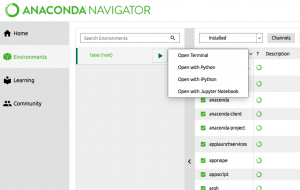
This is a quick post on how to install PyTorch on Anaconda and get started with deep learning projects. As a machine learning enthusiasts, this is the first step in getting started with PyTorch. I followed this steps on Mac Air and got started with PyTorch in no time. Here are the steps: Go to Anaconda tool. Click on “Environments” in the left navigation. Click on arrow marks on “base (root)” as shown in the diagram below. It will open up a small modal window as down. Click open terminal. This will open up a terminal window. Execute the following command to set up PyTorch. Once done, go to Jupyter Notebook window and …
Python – Nested Cross Validation for Algorithm Selection
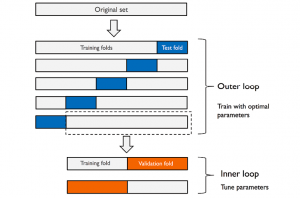
In this post, you will learn about nested cross validation technique and how you could use it for selecting the most optimal algorithm out of two or more algorithms used to train machine learning model. The usage of nested cross validation technique is illustrated using Python Sklearn example. When it is about selecting models trained with a particular algorithm with most optimal combination of hyper parameters, you can adopt the model tuning techniques such as some of the following: Grid search Randomized search Validation curve The following topics get covered in this post: Why nested cross-validation? Nested cross-validation with Python Sklearn example Why Nested Cross-Validation? Nested cross-validation technique is used for estimating …
Randomized Search Explained – Python Sklearn Example
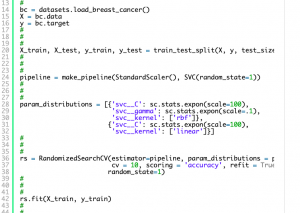
In this post, you will learn about one of the machine learning model tuning technique called Randomized Search which is used to find the most optimal combination of hyper parameters for coming up with the best model. The randomized search concept will be illustrated using Python Sklearn code example. As a data scientist, you must learn some of these model tuning techniques to come up with most optimal models. You may want to check some of the other posts on tuning model parameters such as the following: Sklearn validation_curve for tuning model hyper parameters Sklearn GridSearchCV for tuning model hyper parameters In this post, the following topics will be covered: What and why …
Grid Search Explained – Python Sklearn Examples
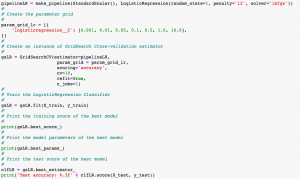
In this post, you will learn about another machine learning model hyperparameter optimization technique called as Grid Search with the help of Python Sklearn code examples. In one of the earlier posts, you learned about another hyperparamater optimization technique namely validation curve. As a data scientist, it will be useful to learn some of these model tuning techniques (tuning hyperparameters) as it would help us select most appropriate models with most appropriate parameters. The following are some of the topics covered in this post: What & Why of grid search? Grid search with Python Sklearn examples What & Why of Grid Search? Grid Search technique helps in performing exhaustive search over specified parameter (hyper parameters) values for …
Validation Curves Explained – Python Sklearn Example
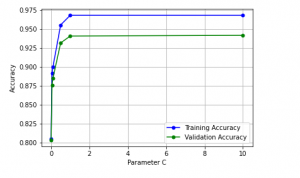
In this post, you will learn about validation curves with Python Sklearn example. You will learn about how validation curves can help diagnose or assess your machine learning models in relation to underfitting and overfitting. On the similar topic, I recommend you reading one of the previous post on assessing overfitting and underfitting titled Learning curves explained with Python Sklearn example. The following gets covered in this post: Why validation curves? Python Sklearn example for validation curves Why Validation Curves? As like learning curve, the validation curve also helps in diagnozing the model bias vs variance. The validation curve plot helps in selecting most appropriate model parameters (hyper-parameters). Unlike learning …
Python – 5 Sets of Useful Numpy Unary Functions
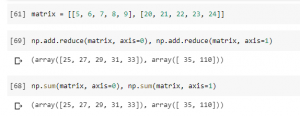
In this post, you will learn about some of the 5 most popular or useful set of unary universal functions (ufuncs) provided by Python Numpy library. As data scientists, it will be useful to learn these unary functions by heart as it will help in performing arithmetic operations on sequential-like objects. These functions can also be termed as vectorized wrapper functions which are used to perform element-wise operations. The following represents different set of popular functions: Basic arithmetic operations Summary statistics Sorting Minimum / maximum Array equality Basic Arithmetic Operations The following are some of the unary functions whichc an be used to perform arithmetic operations: add, subtract, multiply, divide, …
I found it very helpful. However the differences are not too understandable for me